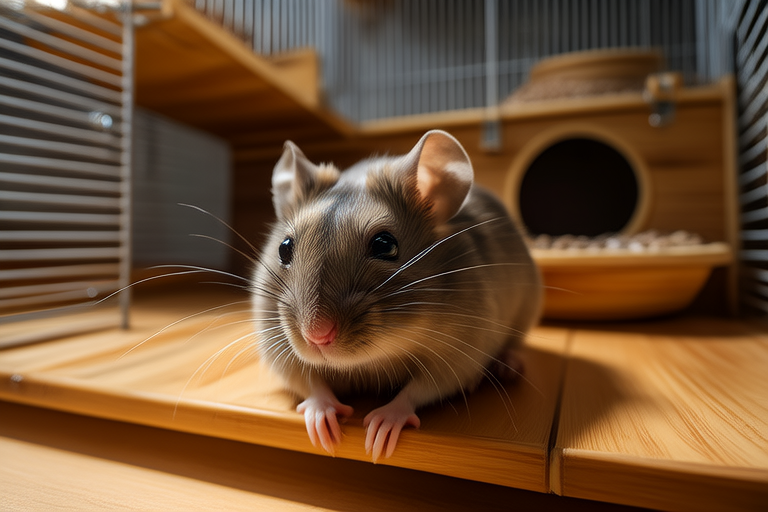The Ultimate Guide: How to Create a Happy Home for Your Fancy Rat
Selecting the Right Cage
Choosing the appropriate cage is crucial for your fancy rat’s well-being. The cage should be large enough to allow your pet to move around freely and explore. A minimum size of 24 inches by 18 inches by 12 inches high is recommended for one rat, with additional space needed for each additional rat. Opt for a cage with multiple levels or platforms to encourage climbing and provide more space. Ensure that the bars are spaced closely enough to prevent escape but not so close as to hinder your rat’s movement.
Ensuring Proper Ventilation and Space
Adequate ventilation is vital for maintaining good air quality within the cage. Avoid cages with solid walls; instead, opt for those with wire mesh sides. This allows fresh air to circulate and prevents the buildup of ammonia from urine, which can cause respiratory problems. Place the cage away from direct sunlight and drafts, ensuring it remains at a comfortable temperature between 65°F and 75°F (18°C and 24°C).
Suitable Bedding Materials
The choice of bedding material is important for your rat’s comfort and health. Use bedding made from recycled paper or wood pulp, such as Carefresh or Yesterday’s News. Avoid pine or cedar shavings, as they contain oils that can irritate your rat’s respiratory system. Provide enough bedding to create a soft, cozy nest area and change it regularly to maintain cleanliness.
Essential Toys and Accessories for Mental Stimulation
Fancy rats are intelligent and active animals that require mental stimulation to stay happy and healthy. Offer a variety of toys and accessories, such as tunnels, chewable items, and hanging ropes. Rotate these toys periodically to keep things interesting. Provide a wheel specifically designed for small rodents to ensure safe exercise. Ensure all toys and accessories are safe, free from sharp edges, and easily cleaned.
Balanced Diet and Nutrition Tips
Feeding your fancy rat a balanced diet is essential for its overall health. Offer a commercial rat food mix that includes seeds, grains, and pellets. Supplement this with fresh fruits and vegetables, such as apples, carrots, and leafy greens, in moderation. Avoid feeding foods high in sugar, salt, or fat. Always provide fresh water daily, either in a sipper bottle or a heavy ceramic dish.
Hygiene and Cleaning Routines
Maintaining cleanliness is key to preventing illness in your fancy rat. Clean the cage weekly, removing all bedding and thoroughly scrubbing the cage and accessories with a mild detergent. Disinfect the cage and accessories using a pet-safe cleaner. Replace bedding regularly, especially in areas where your rat spends most of its time. Regularly clean food and water dishes to avoid bacterial growth.
Safe Handling Techniques
Handling your fancy rat gently and consistently helps build trust and strengthens the bond between you. Support your rat’s body when holding it, being careful not to squeeze or drop it. Allow your rat to get used to being handled gradually, offering treats to encourage positive associations. Never pick up your rat by its tail, as this can cause injury.
Signs of a Healthy Rat
A healthy fancy rat is active, alert, and curious. Its coat should be shiny and free from bald patches or signs of parasites. Check your rat’s eyes, nose, and ears regularly for any discharge or swelling. Listen for even breathing and check its teeth for any overgrowth. A healthy rat will also have a firm body weight and produce regular, formed droppings.
Common Health Issues and Prevention
Some common health issues in fancy rats include respiratory infections, dental problems, and tumors. To prevent respiratory infections, maintain good cage hygiene and ensure proper ventilation. Provide chew toys to help prevent dental issues by keeping teeth worn down. Regular veterinary check-ups can help detect and treat health problems early. Keep an eye out for any changes in behavior, appetite, or appearance that may indicate illness.
Advice on Integrating a New Rat into Your Home
Introducing a new rat to your household requires patience and care. Start by placing the new rat in a separate area within the same room to allow scent exchange. Gradually introduce the rats to each other under supervision, ensuring they get along peacefully. Provide plenty of hiding spots and toys to reduce stress and competition. Monitor their interactions closely and separate them if any aggression occurs.
In conclusion, creating a happy home for your fancy rat involves providing a spacious, ventilated cage, appropriate bedding, stimulating toys, a balanced diet, and regular hygiene. By following these guidelines, you can ensure your rat lives a long, healthy, and joyful life. Remember, the key to a happy home is love, attention, and care. Enjoy the wonderful companionship of your fancy rat!
